by Bill Thompson, III
Editor
The hummingbirds are coming
soon (if they haven't already returned to your backyard and garden).
Here are my top ten things to do to attract (and keep) hummingbirds
in your backyard.
10. Add a new native
plant species to your garden. You just can't have too many good
hummingbird plants in your garden or yard. Take an inventory of your
existing offerings and consult a source of hummer plant info for
ideas on what to add next.
9. Plan a continuous
blooming schedule. When you're leafing through your garden
catalogs or wandering the greenhouses of your favorite garden center
planning your hummer garden, choose plant species that have
different blooming periods. For example, choose a ready-to-bloom
hanging basket of fuschia for early flowers, a fast-growing Salvia
species for midsummer flowers, and a late-blooming trumpet creeper
that will be in flower in late summer and fall. Ask a local
gardening expert for advice on blooming schedules and seasons for
your area, soil type, and climate. Continuous blooming means
hummingbirds will always have a reason to be in your yard,
especially late in the season when flower production is down, but
hummer numbers are up with all the recently fledged
youngsters.
8. Deadhead your flowers
to enhance blooming. This old gardeners' trick is a clever one.
By removing old blossoms (this process is known as "deadheading")
shortly after they have wilted and removing seed heads from blooming
plants, you trick the plants into thinking that their work is not
yet done. The plants respond by continuing to produce flowers and
seed heads, in the end producing far more than they would have if
they had not been deadheaded. Later in the season, you can let the
plants go to seed to ensure that you'll have them back in your
garden next year.
7. Tie an orange ribbon
round the old oak tree. Use foot-long pieces of surveyor's tape
(bright red or orange plastic ribbon sold in hardware stores) to
catch the eyes of passing hummingbirds. Tie these pieces to bushes,
trees, deck railings--anyplace near flowers or feeders. The bright
colors will lure migrant hummingbirds down from the sky for a closer
look. When they get there, they'll find your flowering gardens and
hummer feeders, which might make them decide to stay for more than
just a rest stop. Special thanks to hummingbird guru Bob Sargent for
this idea.
6. Repaint your plastic
flowers; rehab your old feeders. If the red parts on your hummer
feeders are getting a bit dull, you can repaint them using bright
magenta nail polish. Make sure the nail polish is totally dry before
you fill and place the feeder. When dry, the polish's bright color
is a visual signal to hungry hummers.
5. Replace old feeders.
Don't want to waste good nail polish and elbow grease on
rehabilitating your tired, old hummer feeders? Don't be a
cheapskate. Go buy some new feeders. This time, get durable, heavy
plastic feeders. Make sure they are designed for easy filling and
that they come apart for easy cleaning. If you still insist on
getting El Cheapo feeders, start saving now to buy a new batch of
feeders next spring.
4. Make snag perches for
hummers. Bluebirds, kestrels, and flycatchers all like to use
snags for perching. Why do they perch? To rest, to preen, but most
of all, to hunt. Hummingbirds are no different. After beating your
wings at a rate of 80 beats per second, you'd feel like taking a
break, too. All hummers, but especially males, like to perch on the
end of an exposed branch. From this vantage point they can see
danger or rivals approaching. And they can sally forth into the air
to grab a tasty insect, should one happen to fly past. You can
create a hummer snag by sticking a dead branch into the ground so
that it stands vertically. Place it about 50 feet from your feeder,
but still within view. You may find that a territorial male uses the
perch as a watch tower from which to defend a lone feeder. If this
happens, see #1 below.
3. Add a mister to your
yard. A mister is a small-hosed attachment for your regular
garden hose. With the hose turned on to just a trickle, the mister,
with its pinhole openings, shoots a fine spray, or mist, into the
air. Hummingbirds, like all birds, will regularly bathe if a ready
supply of water is at hand. But a mister in action is too much to
resist! Hummingbirds love to fly through the fine spray until they
are thoroughly soaked, at which point they zip off to a handy
preening perch. Misters are available at hardware stores, lawn and
garden centers, specialty bird stores, and by mail order.
2. Don't remove those
spider webs. Hummingbirds use spider web as a main ingredient in
their nests. It's strands of spider web that hold the nest together
and to the branch upon which it is built. But wait, there's more!
Hummingbirds also love to rob insects from spider webs. Insects are
an important source of protein for hummers, and they'll get them
anyway they can. How convenient for hummingbirds to have spider webs
do the catching for them.
1. Got bullies? Add more
feeders in a clump! If you have one male hummingbird that is
dominating your feeder to the exclusion of all others, there are two
ways to afford your other hummers a drink. One is to put up other
feeders on opposite sides of your house, or out of sight of Mr.
Bully. Of course, this may simply mean that you are setting up other
fiefdoms for other male bullies. Perhaps a better solution is to add
two or three more feeders in the vicinity of the first feeder. This
will attract multiple hummers at once, which will quickly cure your
bully of his territoriality. He will not be physically able to fight
off all the other hummingbirds, so he will give up
trying.
|






 Woodside Gardens
The Registry of Nature Habitats
Woodside Gardens
The Registry of Nature Habitats 
 1999 -
1999 -

![[Mourning Dove]](http://www.abirdshome.com/images/mdove1.jpg)
![[Rose Breasted Grosbeak]](http://www.abirdshome.com/images/grosbeak1.jpg)
![[White Breasted Nuthatch]](http://www.abirdshome.com/images/nuthatch1.jpg)
![[Cowbird]](http://www.abirdshome.com/images/cowbird.jpg)
![[Heron]](http://www.abirdshome.com/images/heron.jpg)
![[Water Attracts Wildlife]](http://www.abirdshome.com/images/yard1.jpg)

![[Downy Woodpecker]](http://www.abirdshome.com/images/dwoodpecker1.jpg)
![[Black Capped Chickadee]](http://www.abirdshome.com/images/chickadee1.jpg)
![[Wood Duck]](http://www.abirdshome.com/images/woodduck.jpg)
![[Ponds Attract Wildlife]](http://www.abirdshome.com/images/pond1.jpg)
![[Moths]](http://www.abirdshome.com/images/moth1.jpg)
